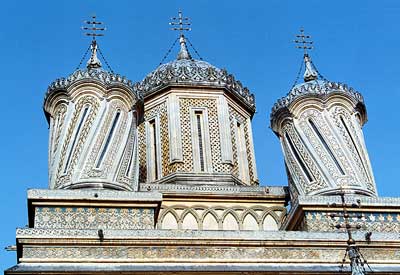
Curtea de Arges monastery, not found in the "fond memories"
section of the photo album of Manole and his wife.
A short way from Ramnicu Valcea, we stopped in the town of Curtea de Arges to see the monastery there. This would be the first in what later seemed to be a non-stop procession of monasteries. For a guy who isn't religious, I sure spent an awful lot of time in churches over there. Although it's a tranquil place today, the monastery has seen its share of exciting times. It is said that the master builder of the place, a guy named Manole, bricked his wife up alive in one of the walls, in accordance with a local custom which supposedly insured good luck for the construction project. I'm guessing the wife's point of view was that a simple blessing by a priest would have been adequate.
 Curtea de Arges monastery, not found in the "fond memories" section of the photo album of Manole and his wife. | Depending on who you ask, Manole either killed himself in remorse later on, or was imprisoned on the roof of the newly-completed building by Neagoe Basarab, the leader who commissioned the building, who ordered the scaffolding removed while Manole was on the roof. The idea was that Neagoe didn't want Manole building a finer building anywhere else. It is said that Manole tried to escape by fashioning wings out of roofing tiles, jumped off the roof, and promptly became road pizza. However, he apparently hit the ground with such a jolt that a new spring gushed forth, and Manole's Well is still there today. |
Now of course, every western-written story about Romania is obligated to mention Dracula, and this seems like a good a place as any. The fictional character of Dracula was created by Bram Stoker after he read lurid accounts of a 15th century Wallachian prince named Vlad Tepes. Vlad's father was also known as Vlad, and because he had been made a knight of the Order of the Dragon by the Holy Roman Emperor Sigismund, he went by the name Vlad Dracul, which means "dragon" or "devil," depending on who you ask. "Dracula" simply means "son of Dracul."
Fortunately for horror fans, but unfortunately for the image of Vlad Jr, the accounts that Stoker read were mostly second- or third-hand tales written by foreigners who had probably never even visited the region, and were gruesomely over-exaggerated.
Mind you, Vlad was no pussycat. His carefree childhood days were cut short somewhat when Papa Vlad sent eight-year-old Vlad Jr. and his brother Radu off as hostages to the Sultan of Turkey in an attempt to score brownie points. Radu coped by sleeping around in the Turkish court, while Vlad watched and learned the Turkish use of terror as a political tool. He learned the lessons well, and after he was freed and became ruler of Wallachia, became known as Tepes, or Impaler, after his predilection for impaling his enemies on wooden stakes, and similar acts of tough love. However, he was pretty good at driving out invading Turk armies, and is thus admired in modern Romania as a tough leader in tough times.
The whole Dracula thing is something that most Romanians sort of roll their eyes in exasperation at, although there are a few places where they do cater to the tourists expecting to get the whole creepy vampire experience. There are a handful of hotels and restaurants that make quite a tidy stack of lei selling foreign tourists things like cheap vodka with red food coloring in it.
My point in mentioning this here is that in Curtea de Arges, we were not too far from the real "Dracula's Castle," that is, a castle where Vlad actually lived. I say "real" here, because there is another "Dracula's Castle, this one in the Transylvanian town of Bran. Although Bran Castle is the one that all the Dracula tours go to, it actually has nothing whatsoever to do with Vlad Tepes...except that some historians think he might have attacked it once. The tour buses go to Bran for several reasons:
In any case, we did NOT visit the real Dracula's castle.
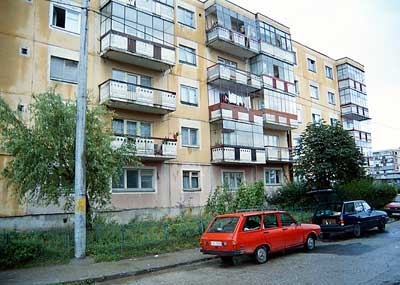 The Ceausescu building where we stayed, and our two little Dacias |
Instead, we headed northeast to the city of Cimpulung, Radu's home town. It's a very old town, dating back at least to Roman times, and was the region's first capital, in 1300. During his disastrous rule, the communist dictator Ceausescu ordered many old and historic places torn down, and then had ghastly "Ceausescu buildings" erected in their place. These are poorly-designed and shoddily-built apartment buildings that are still the prominent feature in many cities. We stayed in a condo belonging to a cousin of Radu's in one of these buildings. On the outside, the buildings are ugly and dilapidated. On the inside, people have frequently fixed them up as best they can. |
Cimpulung happened to be one of those places where the city water supply had not been contaminated, and in our lodgings, we were happy to find that the cold water was icy cold and drinkable. On the other hand, the hot water was...icy cold and drinkable. No showers for us that night. Furthermore, the toilet took the better part of half an hour to refill after a flush. But fortunately, the shower had a rubber hose attached to it that extended far enough to fill the toilet with.
That evening, Radu wanted to take us to a really fancy restaurant in town, but we found it closed that night due to lack of business. We wandered around a bit, and found a small cafe that had passable food.
It was difficult sleeping that night, because some nasty buzzing thing had decided it was its civic duty to harass me through the night. Also, we had more of those World War III thunderstorms.
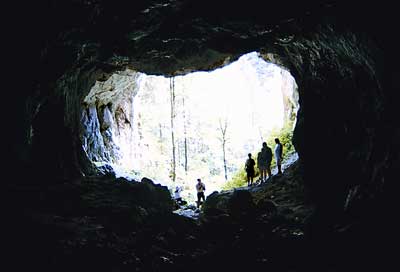 Just inside Bear Cave. What's that noise? |
Along the way, we stopped at a cave called "Bear Cave," but fortunately the bears had apparently gone on vacation for the summer. I like caves, and if I'd known we were going to go to one, I would have brought better equipment. As it was, all I had for light was a bitty little MagLite flashlight. Nonetheless, the less-claustrophobic of us ventured a little way into the cave. Although it seemed at the time that the cave wasn't very big, I later learned that it actually does go quite aways underground. | 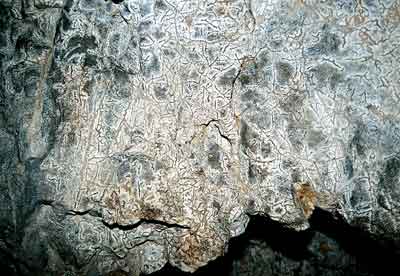 Mineral patterns on the walls |
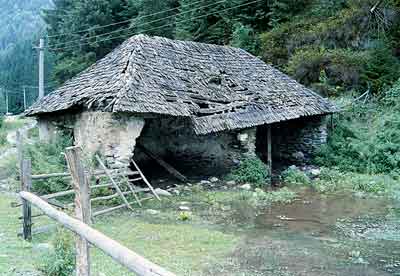 A nearby barn |
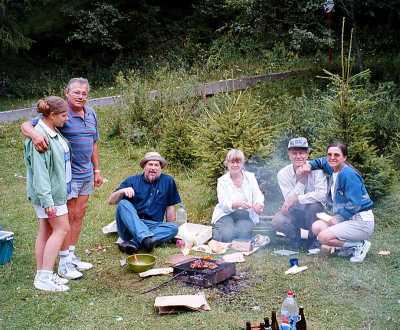 Photo by Kathy Lindquist |
PAGE: 1 | 2 | 3 | 4 | 5 | 6 | 7 | 8 | 9 | 10 | 11 | 12 | 13 | 14